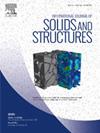Exploring the effects of finite size and indenter shape on the contact behavior of functionally graded thermoelectric materials
IF 3.4
3区 工程技术
Q1 MECHANICS
International Journal of Solids and Structures
Pub Date : 2024-10-03
DOI:10.1016/j.ijsolstr.2024.113089
引用次数: 0
Abstract
The performance enhancement of functionally graded thermoelectric (FGTE) devices is significantly influenced by contact studies of the FGTE materials. It is unclear how the finite thickness and the punch geometry influence the FGTE materials’ contact behaviors. This paper investigates the frictionless contact problem between three types of rigid punches (flat, triangular, and cylindrical) and the FGTE strip with finite thickness. The electric-thermo-elastic parameters of the FGTE strip vary in the thickness direction according to an exponential function. Based on the Fourier integral transform and the transformation matrix method, the problem is transformed into the numerical solution of three sets of singular integral equations. The presence of singular features on either side of the punch demands the adoption of specific collocation strategies. The distribution of the normal current density, the normal energy flux, and the normal contact stress is obtained by adjusting multiple electric-thermo-elastic parameters. The contact stresses in the case of punches with varying shapes can be effectively controlled by modulating the coefficient of thermal expansion and the strip thickness, whereas the effect of the electrical conductivity, the shear modulus, and the thermoelectric load on these stresses depends on whether they are increased or decreased.
探索有限尺寸和压头形状对功能分级热电材料接触行为的影响
功能分级热电(FGTE)器件性能的提高在很大程度上受到 FGTE 材料接触研究的影响。目前还不清楚有限厚度和冲头几何形状如何影响 FGTE 材料的接触行为。本文研究了三种类型的刚性冲头(扁平、三角形和圆柱形)与有限厚度 FGTE 带材之间的无摩擦接触问题。FGTE 带材的电热弹性参数在厚度方向上按指数函数变化。基于傅立叶积分变换和变换矩阵法,问题被转化为三组奇异积分方程的数值求解。冲头两侧奇异特征的存在要求采用特定的定位策略。通过调整多个电热弹性参数,可以得到法向电流密度、法向能量通量和法向接触应力的分布。通过调节热膨胀系数和带材厚度可以有效控制不同形状冲头的接触应力,而电导率、剪切模量和热电负荷对这些应力的影响则取决于它们是增加还是减少。
本文章由计算机程序翻译,如有差异,请以英文原文为准。
求助全文
约1分钟内获得全文
求助全文
来源期刊
CiteScore
6.70
自引率
8.30%
发文量
405
审稿时长
70 days
期刊介绍:
The International Journal of Solids and Structures has as its objective the publication and dissemination of original research in Mechanics of Solids and Structures as a field of Applied Science and Engineering. It fosters thus the exchange of ideas among workers in different parts of the world and also among workers who emphasize different aspects of the foundations and applications of the field.
Standing as it does at the cross-roads of Materials Science, Life Sciences, Mathematics, Physics and Engineering Design, the Mechanics of Solids and Structures is experiencing considerable growth as a result of recent technological advances. The Journal, by providing an international medium of communication, is encouraging this growth and is encompassing all aspects of the field from the more classical problems of structural analysis to mechanics of solids continually interacting with other media and including fracture, flow, wave propagation, heat transfer, thermal effects in solids, optimum design methods, model analysis, structural topology and numerical techniques. Interest extends to both inorganic and organic solids and structures.

 求助内容:
求助内容: 应助结果提醒方式:
应助结果提醒方式:


